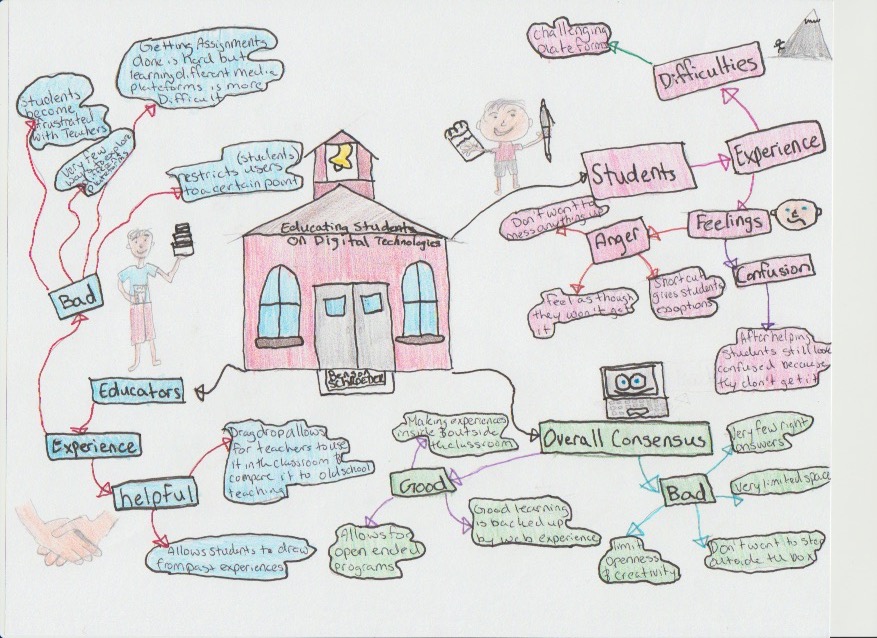In this multimedia reflection on the article Digital Ghosts in the Modern Classroom by Ashley Hinck, I chose to display my thoughts in the form of a sketchnote. Through sketchnote, I was able to show the two different paths that we can teach and demonstrate to students. There is the shortcut route, which is the road that most students take by using templates, drag and drop methods, standardized steps and a guaranteed working final product. Although this route is not preferred due to limiting the creativity of the student, I placed a yellow light at the beginning of the road opposed to a red light to inform students to proceed with caution. This path is not necessarily the wrong path but it is a path that does not show the students full potential. To get the students to show their full potential without the digital ghost in the classroom we need educators to lead students to take risks and encourage them to be creators from a blank canvas. By taking the longer path that may provide a challenge to the students will lead them to a one of a kind masterpiece that is not influenced by the digital ghost or an easy to fill in template. When doing my sketch note, Choose the Creative Path, I felt that I began with a blank canvas eliminating the digital ghost and templates from my reflection. Starting off with a blank canvas definitely had its challenges, mainly just the challenge of starting but it allowed me to use my full creative potential.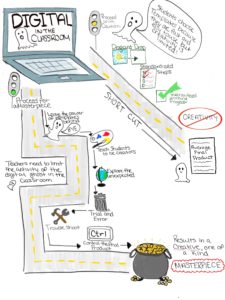
#UWinDig
Ed 322 & 332, University of Windsor
Don’t Understand? Don’t Worry.
Truth be told, I decided to listen to the Hybrid Pedagogy Podcast because I couldn’t bring myself to read the entire article. I would much rather listen to a good discussion about pedagogy than to read about it on my own… In this episode of the podcast, host Chris Friend introduces us to Amy Collier who shares her beliefs about education and her strategies to overcoming standardization in the classroom. She introduces some similar concepts (like the different learning styles of students) and some new concepts (like “not-yetness”). Apparently, sometimes the best way to understanding is to spend time struggling with not understanding! For those of you who can’t bring themselves to read the article or listen to the podcast, here is a short 1:47 Powtoon I created to sum it up and to give you some insight on Amy’s way of Questioning Learning.
For those unfamiliar with Powtoon, it is a program to help create animated displays or mini videos that you can use to explain anything. The website gives an example as using it to evaluate a business. Although, there is somewhat of a learning curve to it and it can be time consuming depending on how much animation you wish to add, I found Powtoon to be extremely useful. It helped me explain exactly what I wanted to and the unique animations help emphasize the key points of the presentation. As a future math teacher, I initially thought that I wouldn’t have any use for this in a math lesson. However, after creating this short video, I can see many uses to it. One idea I had would be an animation to show division. You could show a number being decomposed into all of its factors through a short video. This would help any visual learners you have in a classroom. You could also narrate the video to help any mainly auditory learners. To any other kids in the class with different learning styles, this video can do no harm as it is a fun way to display new concepts. I am a fan of Powtoon and it’s ability to, like Amy, challenge the standardized (chalkboard & textbook) learning that we still experience today in math classes everywhere.
Anyway, enjoy!
Digital Ghost’s in the Modern Classroom and How to Get Rid of Them.
This post will provide a detailed response to the article Digital Ghost in the Modern Classroom by Ashley Hinck. I have decided to share my response in the form of an info graphic using Piktochart. Please follow the link below to check out my response to the article, as well as a short summary of the main ideas Hinck focuses on in her article.
While completing this multimedia response, I felt like I was directly going against what Hinck talks about in her article because of the fact that I used a template to create my Piktochart. However, this experience enforced the part of my reflection that mentions the importance of starting students off with template based websites when they are learning to create because if I was forced to create a multimedia response without being able to use Piktochart or another template/shortcut based website I would have been ten times more anxious going into it then I was.
Piktochart: https://create.piktochart.com/output/32889791-new-piktochart
the reason we dont have flying cars or hover boards (the answer is not what you think!)?
I hope there’s bonus marks for next level clickbait titles, because I nailed it!
This is my multimedia response to the Hybrid Pedagogy podcast. I try to tie in ideas about bureaucracy and technological progress into my response with limited degrees of success. it was my first time using Adobe Premiere in a long while, and it definitely shows. Also, I’ve learned not to use a condenser mic to try to record audio in quiet rooms because all it does it destroy the audio. I wish I had not posted this right before it was due so that it would be buried in all the other submissions, but alas, here we are. It gets a little silly. I’m pretty happy with that default thumbnail though. Hope y’all enjoy. Umm follow my UwinDig twitter I guess? It’s sure to be a hoot.
Here is one of the bad pictures I made to put in the video.

what a hunk
Also, I’m sorry. I accidentally did a swear but it was like my 15th take, and I just wasnt having it (its censored though, please forgive me).
Also, technically the meat and potatoes of the video is only like 5 minutes (from like 0:25-5:30) so its sort of within the time limit.
Edit: updated tags
Edit: I did a twitter thread as a reflection of sorts… click here for that… or maybe i can embed it? we’ll see…
incoming tweet storm.
"REFLECTION OF VIDEO CREATION: A THREAD"
here's a quick (maybe) thread reflecting on the process of… making that video I posted a few tweets ago (like comment subscribe)… #UwinDig pic.twitter.com/tanqH70nGL— mjcsf ? noot* noot** ? (*2020 **sucks) (@mjcsf_) October 3, 2018
yaaaay, sort of…
Mind map of “Digital Ghosts”
Since the article, ‘Digital Ghosts in the Modern Classroom’ by Ashley Hinck discusses stepping away from using short cuts/templates in the classroom and with digital media, I decided to do that as well. I found it ironic that the websites we were encouraged to use for this assignment are prime examples of a template format. Therefore, I decided to make a mind map using sticky notes. The variety of colours and shapes definitely allows the text to stand out, and the pictures are both hand drawn and printed from the internet. I decided to go with a Pacman theme because I believe it’s a creative spin that plays off the idea of ‘digital ghosts’. I really enjoyed this article because it encouraged teachers and students to take creative risks and develop their problem solving skills. I think it’s important for students to learn that failing is fine, as long as you keep trying and never give up. While using guidelines can be useful at the beginning to learn the basics, students should slowly be eased into more independent assignments. Students will have a much more difficult experience if they are forced to immediately avoid using templates. It could even discourage them from being creative in the future.
I think one of the most challenging aspects of this project was being able to keep everything organized and still being creative. I had to create an attention-grabbing item that, at the same time, didn’t overload the senses. Ironically, summarizing the article was the easiest part of this assignment because of the amount of time literally brainstorming how my brainstorm would look. I think using sticky notes turned out to be a great idea for this project because it forced me to shy away from the norm of just writing ideas down on a mind map. With sticky notes, I had to focus on shape and colour coordination and ask: how much text can I fit on one? Do I have enough space to fit all of my ideas on this board? How will these sticky notes affect how many pictures I use? At the end of the day there is one thing I know for certain: I’m definitely keeping my distance from sticky notes for a while.

Just in case you can’t read everything:
1) 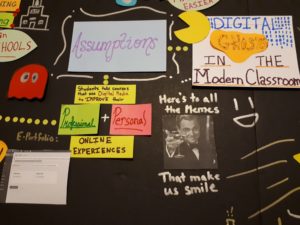
2) 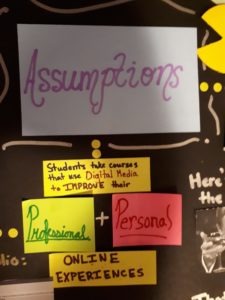
3) 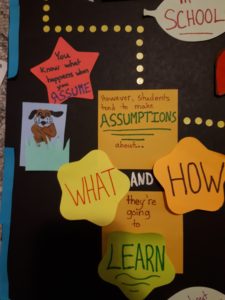
4)
5) 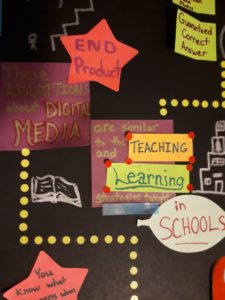
6) 
7) 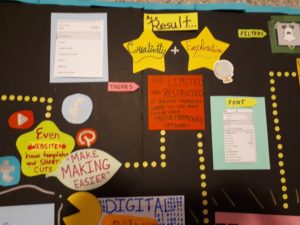
8) 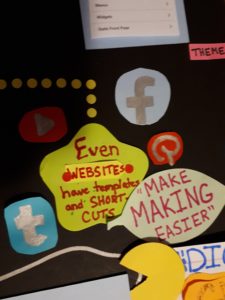
9) 
10) 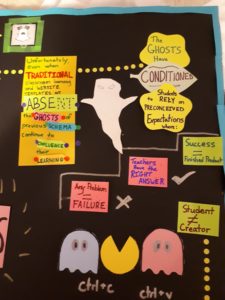
11) 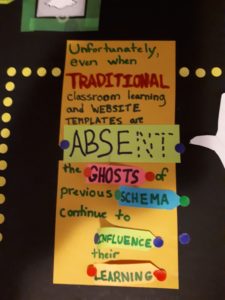
12) 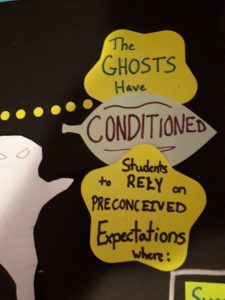
13) 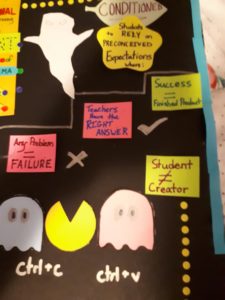
14) 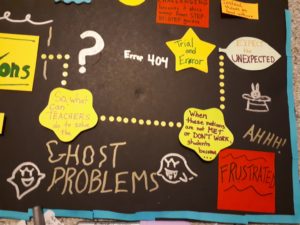
15) 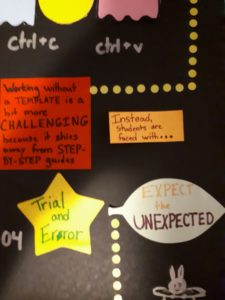
16)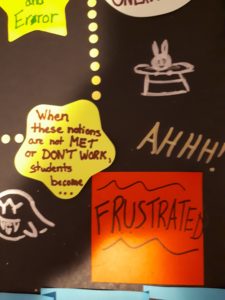
17) 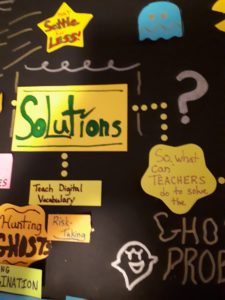
18) 
19) 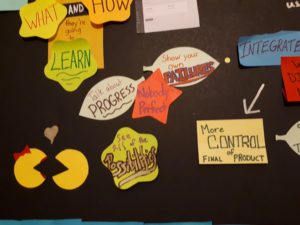
Full view again (magnified):

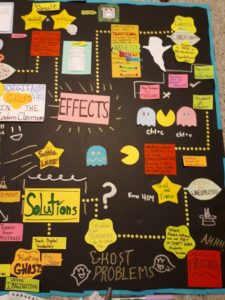
Ghosts in the Digital Age: A Media Reflection
After reading the article Digital Ghosts in the Classroom by Ashley Hinck, I chose to complete an infographic to outline the main takeaways from this paper. In this article, Hinck describes how remnants of previous (older) forms of digital media are currently impacting the way in which student’s creativity and individuality are manifested in the present. More specifically, Hinck describes how students have come to expect that there is a “right answer” for every question or situation that is presented to them, rather than than taking an individualistic or creative approach to arrive at their own solution. After studying the article, I felt as though this tendency to look for one specific answer proved very detrimental to the students, as they were so focused on being correct that they actually lost the majority of their ability to be creative and find novel solutions. This feeling of requiring a “right answer” is something I can personally relate to after completing this assignment, as I am very much a linear learner. Therefore, I found it difficult at times to stay on task and keep in mind where my infographic was ultimately going. As someone who has grown up utilizing various forms of social media such as Facebook and Instagram, I can see in my own work how these forms of digital media ghosts have influenced my own work and creative abilities. More specifically, this assignment and the readings that accompanied it made me realize that my level of creativity and comfort bubble when using these more open forms of digital media (such as the attached infographic) have been heavily impacted by my relatively frequent use of “drag-and-drop” and structured media forms. When I began reading this article, I thought of how detrimental this decrease in creativity and ingenuity could be on students effected by it; but never realized that I may be one of them. However, in my critical analysis of the article, I came to realize that I was very much one of the students who had been influenced by these digital ghosts of structured media forms, without even being aware of it. This ultimately struct me as concerning, as it made me realize that every day we can be negatively impacted by forms of media that many of us include in the “required” section of our daily lives. Overall, I was forced to step out of my comfort zone in creating this infographic, and thus faced a number of challenges in utilizing an entirely new form of media. That being said, I feel as though I have produced a product of digital media that has proven useful for both myself, as well as the people who will be viewing the finished product.
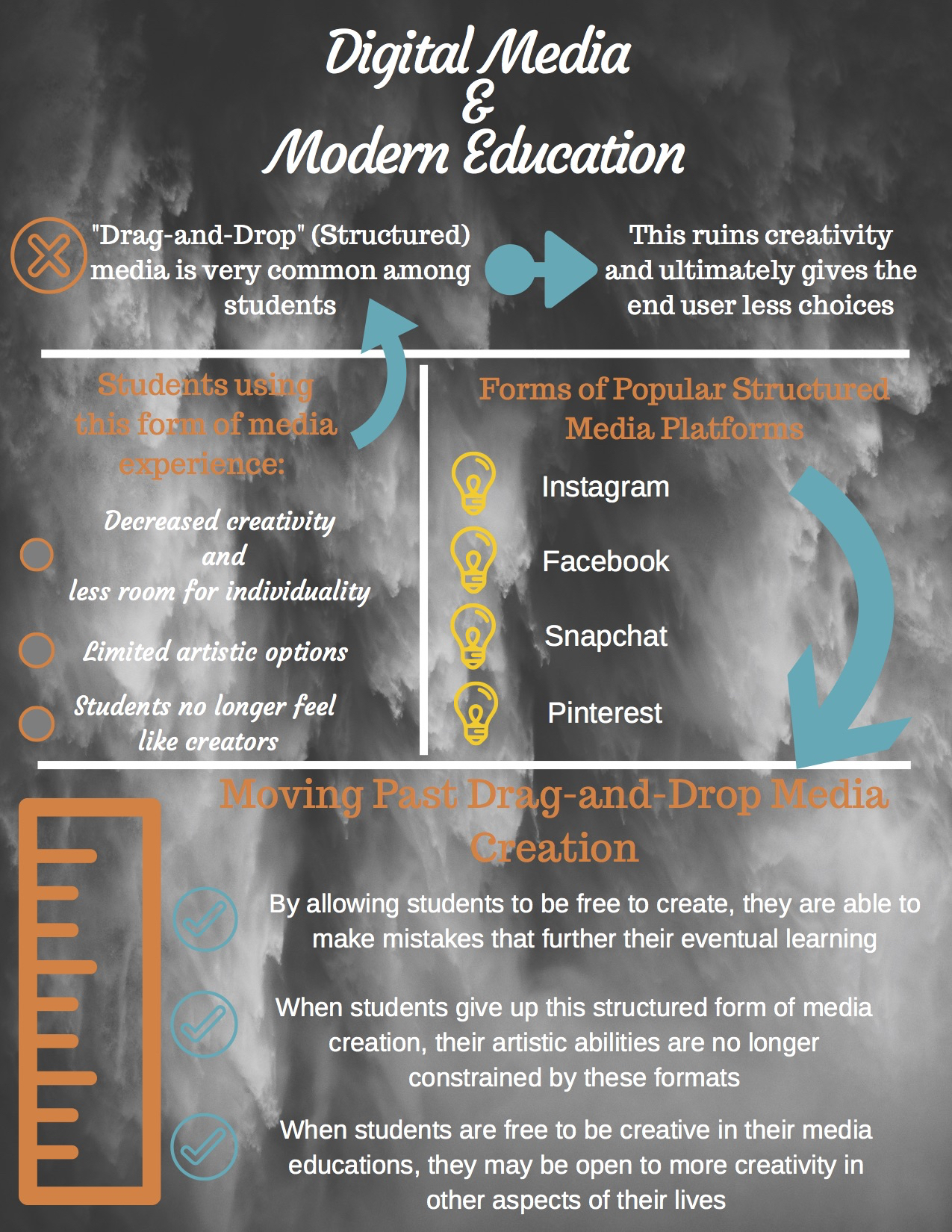
Step Outside Your Comfort Zone
For my assignment, I chose to respond to the article Digital Ghosts in the Classroom by Ashley Hinck. In the article, the author talks about how she is a teacher in a technology class and how students are afraid to fail. She explains that this is because popular template programs are easy to use and present little to no risk of failure. In her class students do coding, meaning producing a “working product” at the end is a huge success. She identifies that a student’s believe digital media making is simply a series of linear steps, with a guaranteed working product at the end, which is not the case. Her class also required students to code their projects in HTML, I can only imagine how steep of a learning curve that would be. Hinck presents her theories on modern education in the article, describing how she believes students entire education is like a template platform; a student performs a series of designed steps, produces a correct answer, and has no risk of failure. I believe she is onto something with that school of thought, you can apply that model of thinking to nearly any course and it is accurate. Here is the link to the article: http://hybridpedagogy.org/digital-ghosts-modern-classroom/
I can relate to this “comfortable path” as I almost chose to do a PowerPoint for this assignment, however, I stepped out of my comfort zone and was able to do a SketchNote. I really enjoyed the process of thinking out how I wanted the final product to look, and figuring out how to illustrate key points in the article. I chose to do the SketchNote because I have never tried anything like this before and thought it would be a good way to experience a new medium. Overall, the learning curve was steep, I had to think about the article in a way that was different from just putting the information summarized into a PowerPoint, but I think I managed to produce something effective in learning. My experience creating the artifact related greatly to the text from the article because I was required to think of the information in a creative way. Hinck says “digital making is not a series of linear steps” as I was working on my SketchNote, I realized how true that is; I often changed my mind and had new ideas pop into my head that ended up altering the final product from how I originally envisioned it. Lastly, in using this medium I found a clear connection to teaching and learning as I continued to create new ideas for my SketchNote, I found the material from the text made more sense to me and deepened my understanding on the topic.
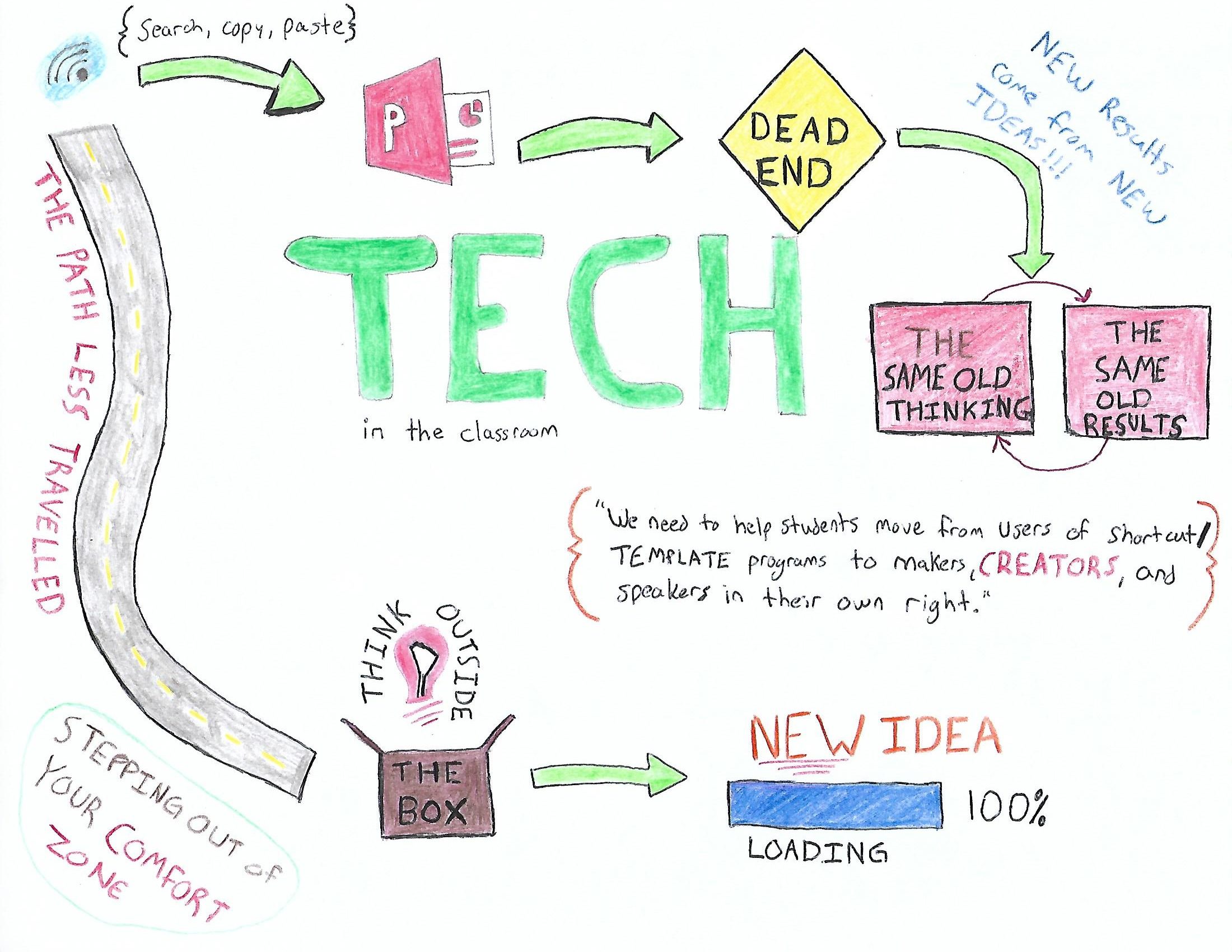
Also, sorry everyone this is sideways.. I have rotated it multiple times and it never stays in landscape mode when I save it.
Template? Nah. Blank Canvas? Yeah!
For my post, I chose to analyze the article Digital Ghosts in the Classroom by Ashley Hinck. This article revolves around the use of templates and digital shortcuts constantly being used by students and teachers in the classroom. I found it very interesting because I have always been a fan of templates and strict guidelines. Similarly, to her main point of the article, I found it much easier to use a template because I was afraid of doing something wrong; it was simple to just pick one and work off of it rather than going through a long process of choosing colours, fonts, backgrounds and much more than I could possibly imagine. She outlines a student’s fear of failure in the trial and error process and that is where I could definitely relate. I usually like to shy away from new things because I am afraid of failing the first time, even if it is a natural process. Hinck claims the school system is set up to have students shy away from trying new things because failure is so frowned upon – shying students away from taking risks. To break these barriers, she suggested troubleshooting with classmates and that is an excellent idea; the chances are very high that there is somebody else in the class that is sharing the same struggles. This article really opened my eyes on the importance of creativity and expanding digital literacy; getting excited about working with less detailed instructions and more so a blank canvas.
Here is my sketchnote; I took one picture of the full document and broke it down into 4 separate pictures to help view them into more detail, I hope it helps!
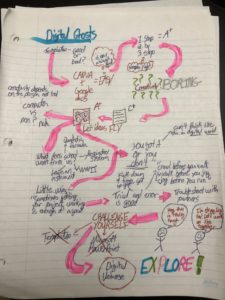
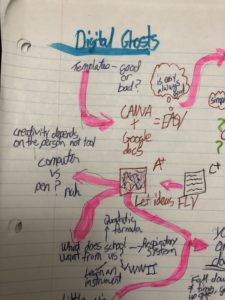
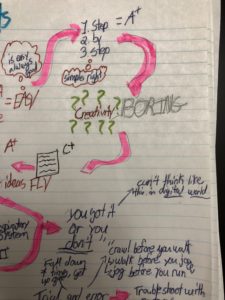
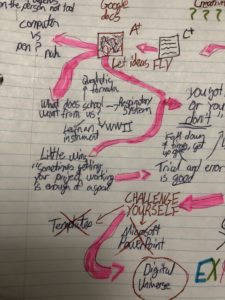
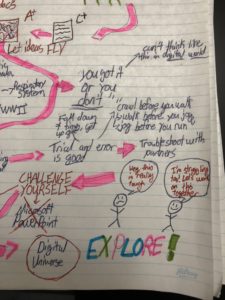
Stepping out of my comfort zone, I did stick with an analog approach, but with more creativity making a sketchnotes page even with my lack of artistic ability. Although it is not technically “digital”, I believe that it has helped me think more creatively and will ultimately help me expand my digital literacies in the future. The process was not easy for me, and the challenge has turned it into a piece that I am proud of. I sat there blankly for about an hour or so, having no clue where to even start. I began with a “rough draft” with a plan to redo it, making it more professional looking but those plans changed. I decided to keep my original sketch as it shows a great development in my creativity as the sketchnote goes on. It is messy, but it really encapsulates the ideas running through my mind while reading this article. Although this particular multimedia piece is not digital, it has shown me that risk-taking is fun and very rewarding, making me very excited to try something new for the next project!
Ain’t Afraid of No Digital Ghosts

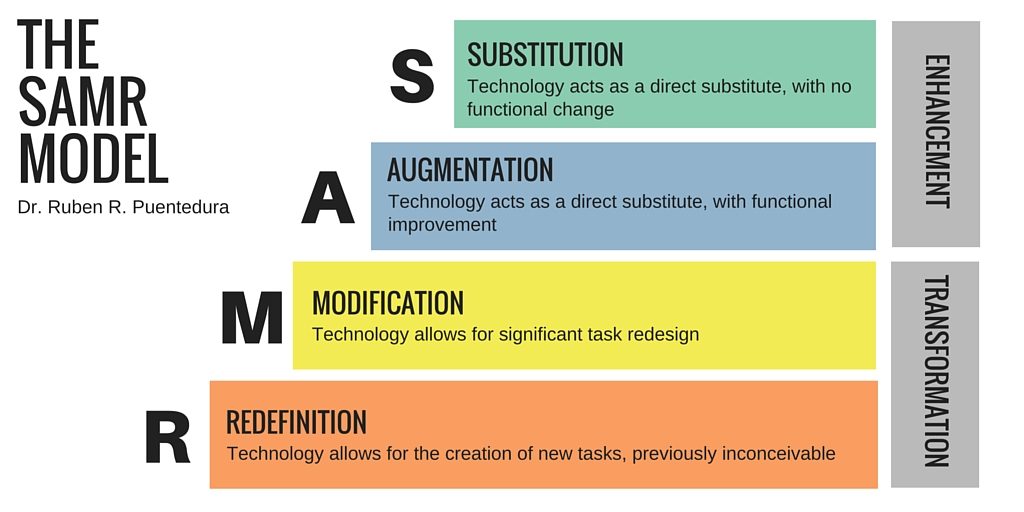
 Technology is a center point to society today and is fundamental to how it functions. With deep-rooted ties to society, it permeates into education. The permeation can prove to be finicky because of improper applications of these external societal resources not fully being useful for students. It is the equivalency of trying to fit a square peg into a round hole. In the article, Digital Ghosts in the Modern Classroom by Ashley Hinck there is the argument for teachers to recognize through their use of technology in their pedagogy the dangers of using templated work. The article is a strong piece that acknowledges that students will not always know the ins and outs of coding and have the skills necessary to maximize their technology and creativity at the same time. There is the concept that Hinck argues that teachers in their pedagogy need to realize how to limit the conformity of templates, yet maximizing the creative results. This concept resonated with me because templates are the foundations to most interactive learning because it allows for that individualized student-centered contributions, yet those same templates are argued to build conformity which is detrimental to this teaching philosophy. Hinck I may not fully agree with for some of their ideas, but they presented information that forces teachers to be leary on the usage of templates within the classroom. This connects directly with the fact that my template has proven limited in how I can manipulate the photos and what I can do with the structure. Hinck argued that there are limitations on templates and this is echoed throughout the process of creating my artifact. On the other side, however, the effort and time that would need to be put in to create the infographic through coding it would have been far more problematic. There would have been issues if even one line of code was off and therefore the amount of trial and error that would take place would bog down the creative ideas. It would force the creator to weigh whether it would have been worth it to add certain information and I would have limited the construction of my infographic if I had to use something like CSS. I found that through my experience of creating this infographic that I had to reflect on tools that I have used in the past. As explained in the infographic there are concerns with Kahoot because they are only tapping into the remember and maybe the understanding levels of Bloom’s Taxonomy which is not where an educator wants to reach for a template based learning tool. From there this made me think about where it falls on the SAMR model and that it was only a substitution form. The Hinck article made me critically reflect on what resources that I have in my tech teaching toolbox and showing me that it was lacking.
Technology is a center point to society today and is fundamental to how it functions. With deep-rooted ties to society, it permeates into education. The permeation can prove to be finicky because of improper applications of these external societal resources not fully being useful for students. It is the equivalency of trying to fit a square peg into a round hole. In the article, Digital Ghosts in the Modern Classroom by Ashley Hinck there is the argument for teachers to recognize through their use of technology in their pedagogy the dangers of using templated work. The article is a strong piece that acknowledges that students will not always know the ins and outs of coding and have the skills necessary to maximize their technology and creativity at the same time. There is the concept that Hinck argues that teachers in their pedagogy need to realize how to limit the conformity of templates, yet maximizing the creative results. This concept resonated with me because templates are the foundations to most interactive learning because it allows for that individualized student-centered contributions, yet those same templates are argued to build conformity which is detrimental to this teaching philosophy. Hinck I may not fully agree with for some of their ideas, but they presented information that forces teachers to be leary on the usage of templates within the classroom. This connects directly with the fact that my template has proven limited in how I can manipulate the photos and what I can do with the structure. Hinck argued that there are limitations on templates and this is echoed throughout the process of creating my artifact. On the other side, however, the effort and time that would need to be put in to create the infographic through coding it would have been far more problematic. There would have been issues if even one line of code was off and therefore the amount of trial and error that would take place would bog down the creative ideas. It would force the creator to weigh whether it would have been worth it to add certain information and I would have limited the construction of my infographic if I had to use something like CSS. I found that through my experience of creating this infographic that I had to reflect on tools that I have used in the past. As explained in the infographic there are concerns with Kahoot because they are only tapping into the remember and maybe the understanding levels of Bloom’s Taxonomy which is not where an educator wants to reach for a template based learning tool. From there this made me think about where it falls on the SAMR model and that it was only a substitution form. The Hinck article made me critically reflect on what resources that I have in my tech teaching toolbox and showing me that it was lacking.
Attached below is the link to my infographic.
https://create.piktochart.com/output/32709526-media-response
Original Hinck Article:
http://hybridpedagogy.org/digital-ghosts-modern-classroom/
Digital Ghost of Classrooms Past
I chose to the do the article rather than the podcast because I found that the article peaked my interest more and was able to better understand the article better than the podcast. The article Digital Ghosts in the Modern Classroom by Ashley Hinck and reviewed by Gregory Zobel, Jessica Knott, and Maha Balihad peaked many things for myself but I decided to specifically to discuss how both teachers and students react to digital media in the classroom as well their experiences.
I found as I read the article that most students are facing the same issues. Some of these issues are that students are afraid of failing and pushing the limits, they would rather think outside of the box because they think it will turn bad if they do so. As teachers, we try to make students more comfortable different media platforms but when teachers try to help students they give them that look like they have four eyes and don’t understand you. I felt as though the students and teachers were so interconnected because we as teachers can learn so much from students as they can from us. The method I decided to use express was a self-made mind map. I thought that this would be the best method to use for the teacher-student similarity.
I used different colours to draw your eyes to different parts of the mind map, I also included a school which is placed in the centre of the mind map because schooling is the central part of this entire article and needs to be the main focus.

